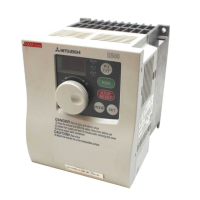What to do if Mitsubishi Electric Inverter operation panel display is not operating?
- JJessica GreenSep 13, 2025
If the operation panel display is not operating, make sure that terminals PC-SD are not shorted.

What to do if Mitsubishi Electric Inverter operation panel display is not operating?
If the operation panel display is not operating, make sure that terminals PC-SD are not shorted.
| Series | FR-S520E |
|---|---|
| Output Frequency | 0.5 to 400 Hz |
| Cooling Method | Fan cooled |
| Input Voltage | 200-240 VAC |
| Input Phase | Single-phase/Three-phase |
| Control Method | V/F Control |
| Overload Capacity | 150% for 60 seconds |
| Protection Features | Overcurrent, Overvoltage, Undervoltage, Overheating, Short Circuit |
| Communication | RS-485 |
| Operating Temperature | -10 to +50 °C |
| Storage Temperature | -20 to +65 °C |
| Humidity | 95% RH or less (non-condensing) |
| Altitude | 1000 m or less |
| Enclosure Rating | IP20 |
Details the standard connection diagram and specifications for main and control terminals.
Explains the layout and connection of main circuit terminals for various inverter models and power inputs.
Guides on using the control circuit terminals, including wiring and logic changes.
Describes various input terminals like start/stop, frequency setting, and multi-speed selection.
Explains how to use specific input signals assigned to terminals like RL, RM, RH, and STR.
Details connections for optional units like brake resistors, brake units, and converters.
Covers connection and communication using the RS-485 connector for parameter units.
Provides general design considerations and safety interlocks for system integration.
Provides a comprehensive list of all parameters with their settings, ranges, and reference pages.
Organizes parameters by their function and application for easier selection and configuration.
Details the purpose, settings, and related parameters for each function/parameter.
Lists and explains various error codes, their causes, and corrective actions for inverter protection.
Provides guidance on diagnosing and resolving common operational issues and faults.
Outlines safety precautions and procedures for routine maintenance and inspection of the inverter.
Details technical specifications including ratings, power supply, cooling, and approximate mass for various models.
Provides outline dimension drawings and mounting hole details for different inverter capacities.
